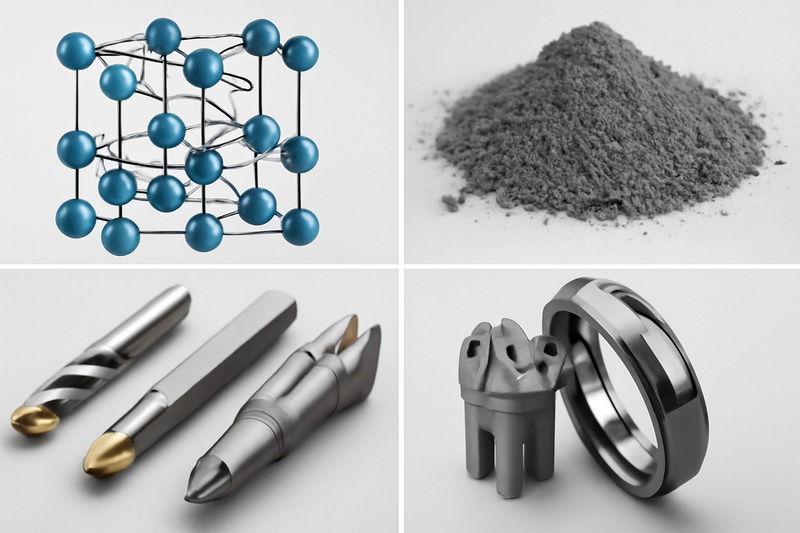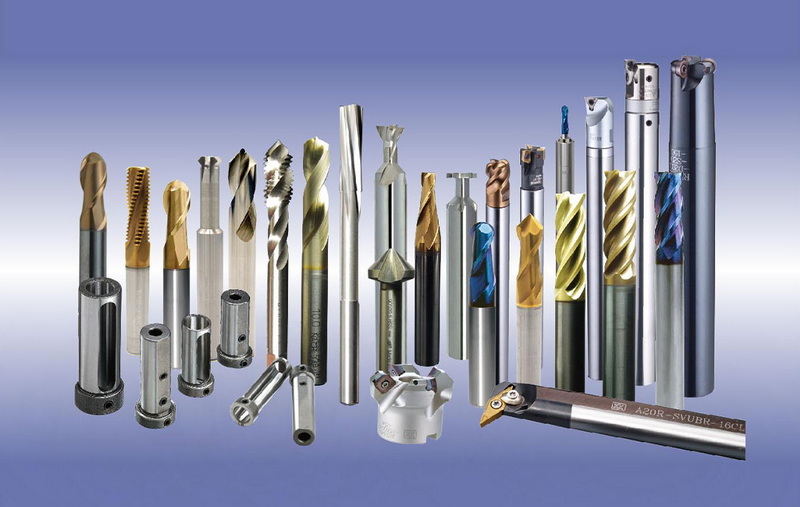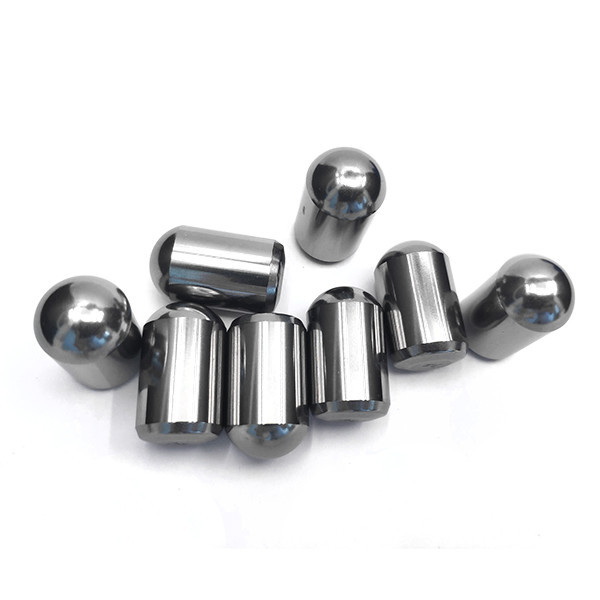Content Menu
● Understanding Tungsten Carbide: Composition and Structure
>> Chemical and Physical Structure
● How Is Tungsten Carbide Made?
>> Powder Synthesis
>> Cemented Tungsten Carbide
● Key Properties of Tungsten Carbide
>> Hardness and Wear Resistance
>> Strength and Toughness
>> Thermal Stability
>> Chemical Resistance
● Applications of Tungsten Carbide
>> Cutting Tools and Machining
>> Mining and Drilling
>> Wear-Resistant Parts
>> Jewelry
>> Aerospace and Defense
● Types of Tungsten Carbide
● Advantages of Tungsten Carbide Over Other Metals
● Limitations and Considerations
● Advanced Manufacturing Techniques for Tungsten Carbide
>> Additive Manufacturing (3D Printing)
>> Hot Isostatic Pressing (HIP)
>> Coating Technologies
● Environmental and Safety Considerations
● Tungsten Carbide in Emerging Technologies
>> Medical Applications
>> Electronics Industry
>> Renewable Energy
● Maintenance and Care of Tungsten Carbide Tools
● Conclusion
● Frequently Asked Questions (FAQ)
>> 1. What is tungsten carbide made of?
>> 2. How does tungsten carbide compare to steel?
>> 3. Why is cobalt used in tungsten carbide?
>> 4. Can tungsten carbide be used at high temperatures?
>> 5. Is tungsten carbide resistant to corrosion?
Tungsten carbide is a unique and highly versatile material widely used in various industrial applications due to its exceptional hardness, strength, and durability. Despite often being referred to as a metal, tungsten carbide is actually a ceramic compound composed of tungsten and carbon atoms, combining the properties of both metals and ceramics. This article explores in detail what tungsten carbide is, its composition, properties, synthesis, applications, and why it stands out as a critical material in modern industry.

Understanding Tungsten Carbide: Composition and Structure
Tungsten carbide (chemical formula WC) is a compound formed by the chemical bonding of equal parts tungsten (W) and carbon (C) atoms. It typically appears as a fine gray powder but can be processed into solid shapes through sintering, where the powder is pressed and heated to form dense, hard materials.
Chemical and Physical Structure
- Chemical Composition: Tungsten carbide consists of tungsten and carbon atoms bonded in a 1:1 ratio, forming a dense hexagonal crystal structure.
- Crystal Structure: The hexagonal crystal lattice gives tungsten carbide its remarkable hardness and stiffness, with tungsten and carbon atoms arranged in a trigonal prismatic coordination.
- Physical Properties: It has a very high melting point of approximately 2,780°C and a boiling point near 6,000°C. Tungsten carbide is about twice as dense as steel, with a specific gravity of around 15.6.
- Hardness: Ranking about 9 on the Mohs scale, tungsten carbide is extremely hard, second only to diamond. Its Young's modulus is approximately 530–700 GPa, nearly double that of steel, indicating exceptional stiffness.
How Is Tungsten Carbide Made?
The production of tungsten carbide involves several sophisticated processes primarily rooted in powder metallurgy.
Powder Synthesis
- Tungsten powder and carbon sources (such as graphite or carbon black) are reacted at high temperatures (typically between 1,400°C and 2,000°C) to form tungsten carbide powder.
- Alternative methods include chemical vapor deposition and fluid bed processes, where tungsten oxides react with carbon-containing gases under controlled conditions to produce WC powder.
Cemented Tungsten Carbide
- To enhance toughness and usability, tungsten carbide powder is mixed with a metallic binder, usually cobalt, and sometimes nickel or iron.
- This mixture is pressed into the desired shape and sintered at high temperatures (around 1,400°C to 1,600°C). During sintering, the binder melts and binds the tungsten carbide grains together, forming a composite known as cemented carbide or hard metal.
- The cobalt binder provides toughness, while the tungsten carbide grains provide hardness and wear resistance.
Key Properties of Tungsten Carbide
Hardness and Wear Resistance
Tungsten carbide is renowned for its extreme hardness, which makes it highly resistant to abrasion and wear. This property allows tools made from tungsten carbide to maintain sharp edges and resist deformation under stress.
Strength and Toughness
While pure tungsten carbide is very hard but brittle, the addition of cobalt binder enhances toughness, allowing the material to withstand impacts and mechanical stresses without fracturing.
Thermal Stability
Tungsten carbide maintains its strength and hardness even at elevated temperatures, making it ideal for high-speed cutting tools and applications involving heat.
Chemical Resistance
It is chemically stable in many environments, resistant to oxidation at room temperature, and does not dissolve in water or common acids like hydrochloric or sulfuric acid. However, it can react with nitric acid and halogens at elevated temperatures.
Applications of Tungsten Carbide
Tungsten carbide's unique combination of hardness, toughness, and thermal stability makes it indispensable in many industries.
Cutting Tools and Machining
- Used extensively in manufacturing cutting tools such as drill bits, saw blades, milling cutters, and lathe tools.
- Its ability to operate at higher cutting speeds than high-speed steel improves productivity and tool life.
Mining and Drilling
- Tungsten carbide is used in mining tools, rock drilling bits, and wear parts due to its resistance to abrasion and impact.
Wear-Resistant Parts
- Components like nozzles, valve seats, and bearings benefit from tungsten carbide's durability.
Jewelry
- Due to its hardness and scratch resistance, tungsten carbide is also popular for making rings and other jewelry items.
Aerospace and Defense
- Used in armor-piercing projectiles and aerospace components due to its density and strength.

Types of Tungsten Carbide
There are variations in tungsten carbide materials depending on the grain size of WC particles and the amount and type of binder metal used.
| Type | Description | Properties |
| Submicron Grain WC | Very fine grains (<1 µm), high hardness, used for precision cutting tools | High hardness, lower toughness |
| Fine Grain WC | Grain size around 1-3 µm, balanced hardness and toughness | Good wear resistance and durability |
| Medium and Coarse Grain WC | Larger grains (>3 µm), higher toughness, used for heavy-duty applications | More impact resistant, less hard |
| Binder Variations | Cobalt is common, but nickel or iron may be used to alter toughness and corrosion resistance | Tailored mechanical and chemical properties |
Advantages of Tungsten Carbide Over Other Metals
- Superior Hardness: Harder than most steels and many other alloys.
- High Wear Resistance: Lasts longer under abrasive conditions.
- Thermal Stability: Maintains properties at high temperatures.
- Corrosion Resistance: Stable in many chemical environments.
- Density: Higher density than steel, providing strength in smaller volumes.
Limitations and Considerations
- Brittleness: Pure tungsten carbide can be brittle; binder metals are essential for toughness.
- Cost: More expensive than conventional tool steels.
- Machining: Difficult to machine due to hardness; usually shaped by grinding or electrical discharge machining.
- Oxidation: Begins to oxidize at temperatures above 500°C, limiting some high-temperature applications.
Advanced Manufacturing Techniques for Tungsten Carbide
Recent advances in manufacturing technology have expanded the capabilities and applications of tungsten carbide.
Additive Manufacturing (3D Printing)
- Emerging techniques allow tungsten carbide composites to be fabricated using additive manufacturing, enabling complex shapes and customized tooling.
- This method reduces waste and shortens production cycles compared to traditional subtractive methods.
Hot Isostatic Pressing (HIP)
- HIP is a process where tungsten carbide powders are subjected to high temperature and isostatic gas pressure, resulting in dense, uniform materials with improved mechanical properties.
- This technique enhances toughness and reduces internal defects.
Coating Technologies
- Tungsten carbide coatings applied by physical vapor deposition (PVD) or chemical vapor deposition (CVD) improve surface hardness and wear resistance of cutting tools and machine parts.
- These coatings are thinner and more uniform than traditional hard metal inserts, extending the life of tools.
Environmental and Safety Considerations
While tungsten carbide is highly durable, its production and disposal pose environmental challenges.
- Mining Impact: Tungsten mining involves extraction of tungsten ores, which can disrupt ecosystems if not managed responsibly.
- Recycling: Tungsten carbide is recyclable, and recycling reduces the need for new mining. Scrap carbide tools and parts are often collected and processed to recover tungsten and cobalt.
- Health Risks: Fine tungsten carbide dust can pose respiratory hazards during manufacturing, requiring proper ventilation and protective equipment.
Tungsten Carbide in Emerging Technologies
Medical Applications
- Tungsten carbide is used in surgical instruments and dental tools due to its biocompatibility and ability to maintain sharpness.
- It is also explored for use in implants and prosthetics where extreme wear resistance is needed.
Electronics Industry
- Due to its electrical conductivity and hardness, tungsten carbide components are used in electronic contacts and microelectromechanical systems (MEMS).
Renewable Energy
- Tungsten carbide's wear resistance is beneficial in wind turbine components and other renewable energy machinery subjected to harsh environments.
Maintenance and Care of Tungsten Carbide Tools
Proper maintenance extends the life and performance of tungsten carbide tools.
- Cleaning: Remove debris and residues after use to prevent corrosion of binder metals.
- Sharpening: Use diamond grinding wheels for sharpening; avoid conventional steel abrasives.
- Storage: Store in dry, controlled environments to minimize oxidation and moisture exposure.
- Inspection: Regularly check for cracks or wear to prevent tool failure during operation.
Conclusion
Tungsten carbide is a remarkable material that blurs the line between metals and ceramics. Its exceptional hardness, strength, and resistance to wear and heat make it indispensable in a wide range of industrial and commercial applications. From cutting tools and mining equipment to jewelry and aerospace components, tungsten carbide's unique properties ensure it remains a material of choice where durability and performance are critical. Advances in manufacturing and coating technologies continue to expand its applications, while recycling efforts help mitigate environmental impacts. Understanding its composition, synthesis, properties, and care allows industries to maximize the benefits of tungsten carbide and innovate for the future.

Frequently Asked Questions (FAQ)
1. What is tungsten carbide made of?
Tungsten carbide is made from tungsten and carbon atoms chemically bonded in a 1:1 ratio, often combined with a metallic binder like cobalt to form a composite material with enhanced toughness.
2. How does tungsten carbide compare to steel?
Tungsten carbide is approximately three times stiffer and much harder than steel. It maintains its hardness at higher temperatures and has superior wear resistance, making it ideal for cutting and drilling tools.
3. Why is cobalt used in tungsten carbide?
Cobalt acts as a binder metal in cemented tungsten carbide, providing toughness and binding the hard tungsten carbide grains together, which helps prevent brittleness and improves impact resistance.
4. Can tungsten carbide be used at high temperatures?
Yes, tungsten carbide retains its hardness and strength at elevated temperatures, making it suitable for high-speed cutting tools and other applications involving heat.
5. Is tungsten carbide resistant to corrosion?
Tungsten carbide is chemically stable and resistant to many acids and oxidation at normal temperatures. However, it can react with certain chemicals like nitric acid and halogens under specific conditions.
















